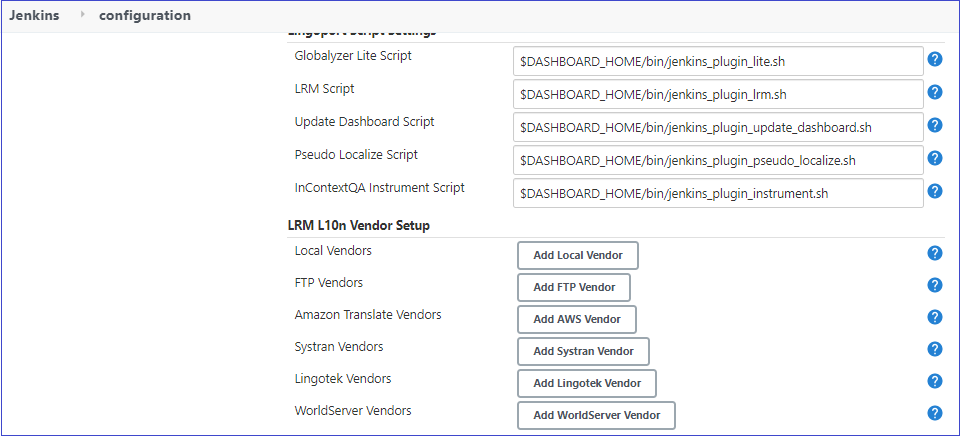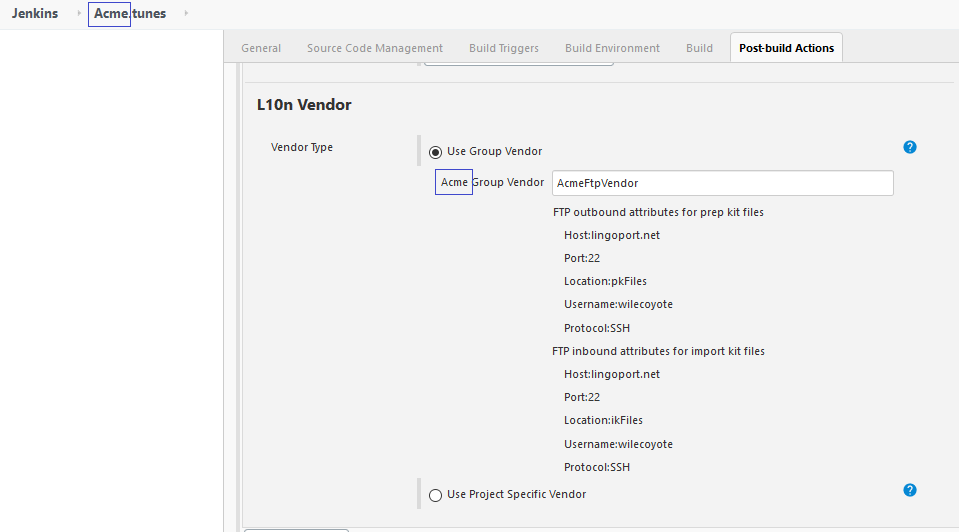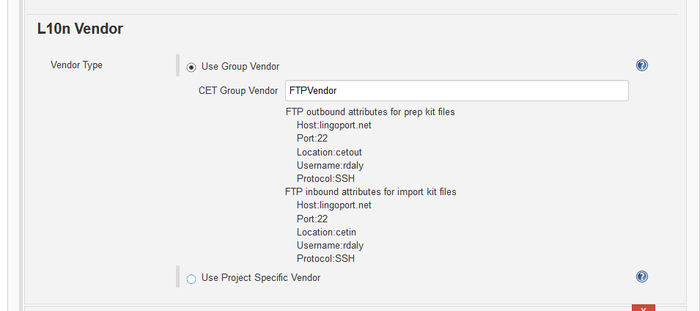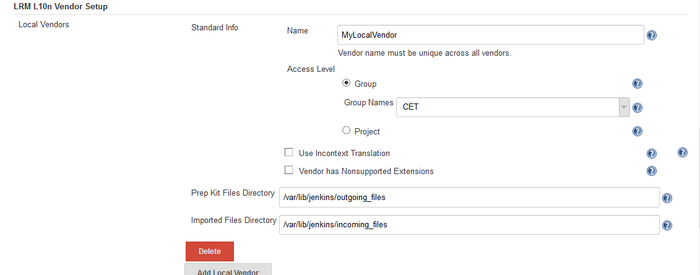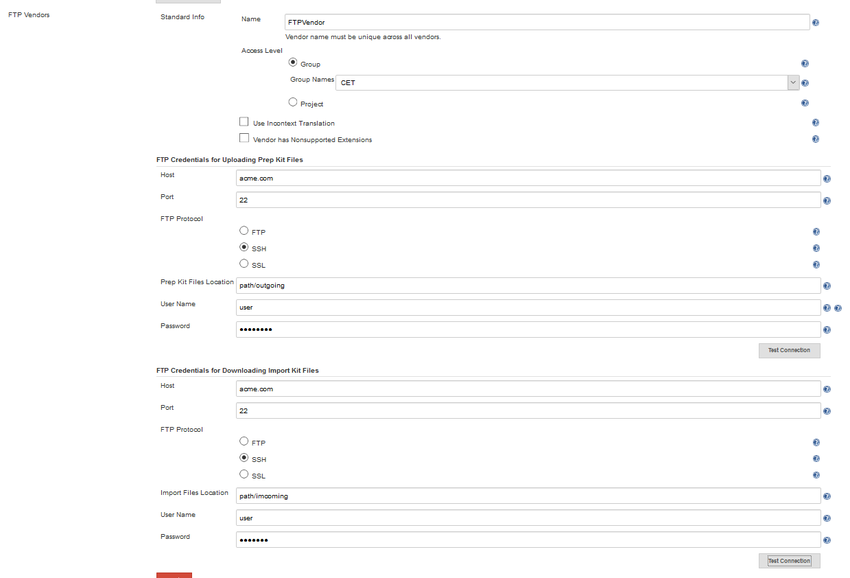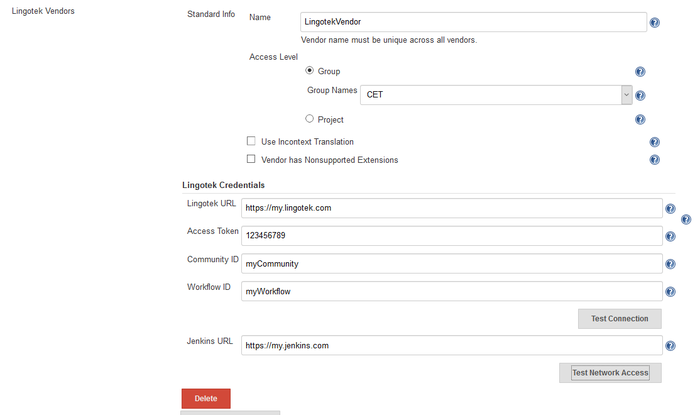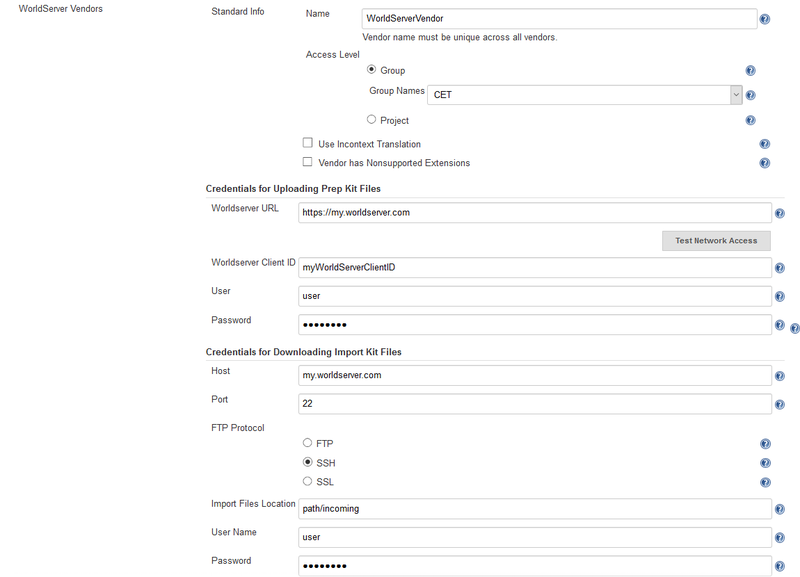Difference between revisions of "L10n Vendors and Integration"
(→Group Level) |
(→Linking the LRM project to the defined group vendor) |
||
| Line 71: | Line 71: | ||
====== Linking the LRM project to the defined group vendor ====== |
====== Linking the LRM project to the defined group vendor ====== |
||
| − | When setting up the L10n Vendor with a group access level, a LRM group was selected. When the |
+ | When setting up the L10n Vendor with a group access level, a LRM group was selected. When the LRM Automation Job is configured for a particular LRM project then the corresponding group L10n Vendor information is displayed. If there is no corresponding group L10n Vendor that has been created then a message will be displayed. See [[On_Boarding_an_LRM_Project#On_Boarding_the_LRM_Automation_Job|On Boarding the LRM Automation Job]] for more information. |
| + | |||
| + | In the example below, a group access level L10n Vendor has been created for group ''Acme''. The ''Use Group Vendor'' option is selected because the project can use the L10 Vendor config file that was created during the Vendor config setup. |
||
| − | In the example below, a group access level L10n Vendor has been created for group ''Acme''. |
||
[[File:LinkGroupVendorToProject.png]] |
[[File:LinkGroupVendorToProject.png]] |
||
Revision as of 17:09, 10 July 2020
Contents
- 1 What are L10n Vendors?
- 2 Supported L10n Vendors
- 3 Recommended Approach
- 4 How do I set the transmission protocol?
- 5 Advanced FTP Vendor issues
- 6 Translation FTP Vendor Integration
- 7 How do I setup a proxy for a project's FTP server?
- 8 Encoding of translated files
What are L10n Vendors?
LRM packages the resources files and send them to localization service providers and translation management systems to translate the files. There are many ways to send the files and they can be done a number of different ways that depend on a different factors including the translation management system.
Supported L10n Vendors
To get a current list of LSP (localization service provider) and TMS (translation management system) companies that are integrated with LRM, please email sales@lingoport.com.
Recommended Approach
Lingoport FTP Protocol
Lingoport strongly recommends using the FTP protocol. With that approach,
- Lingoport automatically pushes valid resource files to be translated following a specific naming convention to an FTP end point
- The translation group picks up the files and on-boards them in the TMS following their own automated pattern
- The translation group returns the translated resource files to another FTP end point as per their system
- LRM picks up the translated files, validates them, and imports them into the proper repository
Advantages
- Robustness: FTP has been in place for decades and is one of the most reliable protocols for transmitting files from one system to another
- Simplicity: FTP and zip are well known and are well understood in the industry
- Security: FTP support SSH and SSL encryption; The FTP system can allow only some IP ranges to access the FTP port(s)
- Automation: LRM pushes and retrieves files automatically; The translation group supplies the automation to and from the automation end point
- Network Failure Handling: If the network goes down when accessing FTP, files are resent later when the network is up; Files are not lost due to downtime
- Asynchronicity: The LRM system and the TMS do not need any special connection; Files can be sent and received independently
- Scalability: The volume sent to an FTP system does not slow down either LRM or a TMS due to traffic. Each system can push or retrieve files without slowing down the other. FTP supports large volume of data
- Configurability: Configuring the FTP end point location is something well understood by IT departments and simple to configure (for LRM, see below)
- Testability: Checking the proper configuration is straightforward
- Fast Set Up: Given the above, setting up LRM with FTP is the fastest and simplest route
Note: Lingoport has set up LRM over FTP with many Translation Groups and the TMS of their choice and any TMS vendor can add their system to this integration pattern.
Resource File Transmission Protocols
For most use cases, Lingoport recommends sending files to translation over SFTP. Direct API-based connections are also available to some TMS systems.
Overall, LRM supports several localization paths for sending files to be translated. They are:
Typical:
- Local
- Files are kept on the system LRM resides on. Good for debugging.
- FTP
- FTP/SFTP. Typical method of sending resource files to/from translation.
API Based:
- GlobalLink
- Lingotek
- WorldServer
- Memsource
- XTM
- Machine Translation
- Aws Amazon Translate
- SYSTRAN Pure Neural® Server
How do I set the transmission protocol?
Setting the transmission protocol has changed significantly over the releases. Setting the protocol is now done through Jenkins configuration. In Jenkins, select Manage Jenkins in the left menu and then Configure System. Scroll down to LRM L10n Vendor Setup.
Standard Vendor Info
Name
The vendor name is used by a Jenkins job/LRM Project to define the L10n Vendor configuration to use. Vendor Name must be unique across all defined L10n Vendors.
Access Level
Group Level
If the group access level is selected, then the configuration will be available to a LRM project at the group level. When these settings are saved, a L10n Vendor configuration file will be created in the selected group's configuration folder. If the access level is changed to project or configuration deleted, then on save, the group's configuration file will be deleted.
The group drop-down is populated with all the LRM groups. The selected group must be unique across all the L10n Vendors otherwise a fatal error will occur when the global settings are saved.
Linking the LRM project to the defined group vendor
When setting up the L10n Vendor with a group access level, a LRM group was selected. When the LRM Automation Job is configured for a particular LRM project then the corresponding group L10n Vendor information is displayed. If there is no corresponding group L10n Vendor that has been created then a message will be displayed. See On Boarding the LRM Automation Job for more information.
In the example below, a group access level L10n Vendor has been created for group Acme. The Use Group Vendor option is selected because the project can use the L10 Vendor config file that was created during the Vendor config setup.
Project Level
If the project access is selected, then the configuration will be available to a LRM project at the project level.
If the configuration access level is changed from project to group (or deleted), then the configuration file for any Jenkins job/LRM project that use this vendor name's configuration will be deleted.
Linking a LRM Project to your vendor
A LRM project is linked to the vendor through the project's job configuration. See On Boarding the LRM Automation Job
Select Use Project Specific Vendor if your project has a different protocol then the rest of the projects in the group. The next time that the job is built, the L10n Vendor Config file will be created in the L10nStreamling project's config file.
Select Use Group Vendor if your project can use the L10 Vendor config file that was created during the Vendor config setup.
In the example below, a vendor FtpVendor was created with Group Access
Incontext Translation
For more info see Incontext User Guide
InContext URL
The URL of your InContext Server for InContext Translation.
InContext Token
The Incontext Token value must match one of the Tokens configured on the Settings page of the InContext Server. Together with the InContext Server URL, the token is used to display the content to the translator for InContext Translation. This authorization token will be supplied by your InContext Server administrator.
InContext Unique Tag
A special tag is used when sending changed content to your L10n Vendor. The default tag is LRM_INCONTEXT. Some L10nVendors may require their own tag to delineate InContext information. If so then enter the tag here.
InContext File Decoration
Example of Default Incontext Tag
When prepping a kit where there is a valid InContext server configuration as above, each of the keys that need to be translated will have an InContext tag above the key. The default tag prefix is LRM_INCONTEXT since there is no InContext Unique Tag.
Below are examples of the decoration that occurs in the prep kit files.
- XML type prep kit file
<?xml version="1.0" encoding="UTF-8"?> <!--MyProject_8_6 - CHANGES-ONLY--> <resources> <!--LRM_INCONTEXT http://ec5-4-3-2-1.amazonaws.com:8081/incontext-server/lookup?key=3130_192&token=0qhZ9yTvtW5--> <string name="Hello">Hello</string>
- Properties type prep kit file
#MyProject_1_4 - CHANGES-ONLY #LRM_INCONTEXT http://ec5-4-3-2-1.amazonaws.com:8081/incontext-server/lookup?key=422_238&token=0qhZ9yTvtW5 myString=Hello
Example of Unique Incontext Tag
When prepping a kit where there is a Incontext Unique Tag defined, each of the keys that need to be translated will have the defined InContext Unique Tag above the key.
Below are examples of the decoration that occurs in the prep kit files for a unique incontext tag.
- XML type prep kit file
<?xml version="1.0" encoding="UTF-8"?> <!--MyProject_8_6 - CHANGES-ONLY--> <resources> <!--SOME_UNIQUE_TAG http://ec5-4-3-2-1.amazonaws.com:8081/incontext-server/lookup?key=3130_192&token=0qhZ9yTvtW5--> <string name="Hello">Hello</string>
- Properties type prep kit file
#MyProject_1_4 - CHANGES-ONLY #SOME_UNIQUE_TAG http://ec5-4-3-2-1.amazonaws.com:8081/incontext-server/lookup?key=422_238&token=0qhZ9yTvtW5 myString=Hello
Vendor has unsupported file types
Some L10 Vendors do not supported all the extensions types that LRM supports. If this is true for one of your Vendors then select the checkbox to display the supported extensions that have an OTB conversion. If an extension cannot be transformed by LRM (not in the drop down) then special transforms can be created by Lingoport.
Local Vendor
A local vendor uses the current system for the incoming and outgoing files.
- Set the name of the vendor. This can be anything descriptive that can be selected in the automation jobs.
- Set the names of the incoming and outgoing file locations.
- XTM and Memsource use the local vendor for their configurations. Continuing to these links gives more information.
FTP Vendor
- Set the name of the vendor. This can be anything descriptive that can be selected in the automation jobs.
- Set the hostname for uploading files and for downloading files and the respective file location, username, and password. Test the Connection to make sure that the system can communicate with the host.
- Often FTP uses port 22 and SSH. Change this if the configuration differs.
Lingotek Vendor
- Set the name of the vendor. This can be anything descriptive that can be selected in the automation jobs.
- Set the Lingotek credentials. If these are unknown, contact Lingotek or support@lingoport.com.
- The Jenkins URL will be something like: https://<IP address>/jenkins. Probably of the current system.
- See advanced Lingotek vendor issues for more Lingotek configuration details.
WorldServer Vendor
- Set the name of the vendor. This can be anything descriptive that can be selected in the automation jobs.
- Set the credentials for WorldServer. Contact WorldServer for these values.
- Set the host, port, location and username and password for the files to download and import.
- See advanced WorldServer vendor issues for more WorldServer configuration details.
Historically, the type of L10n Vendor was defined in the config_l10n_vendor.properties file that can exist at either the group or project level. However, since it is now part of the Jenkins configuration, this is obsolete. Manual changes to this file may be overwritten by the Jenkins configuration.
The default location of the config_l10n_vendor.properties file is at the group level in /var/lib/jenkins/Lingoport_Data/L10nStreamlining/<group-name>/config.
Machine Translation Vendors
AWS Amazon Translate
Systran
See the Systran wiki page for information on how to set up a Systran Vendor.
Advanced FTP Vendor issues
How do I create the SSH keys?
See http://www.linuxproblem.org/art_9.html.
How do I hide the password?
Use a .netrc file, The .netrc file is located in the $HOME directory.
Example of a .netrc:
machine ftp.company.net login username password myPassword
Then ftp ftp.company.net will use the login and username in the .netrc file to connect and the username password are not visible.
I configured a vanilla FTP (not SSH or SSL) and I get an SSH error
If you configure an FTP end point and you get a message from SSH, it means you are reaching an SSH FTP endpoint and that endpoint does not understand the request which follows a different protocol (FTP).
For instance, you may get this error:
org.apache.commons.net.MalformedServerReplyException: Could not parse response code.Server Reply: SSH-2.0-OpenSSH_4.3
A possible issue may be the port number: port 22 is typically used for FTP/SSH; port 21 is typically used for vanilla FTP. Change the port number in config_l10n_vendor.properties and test again.
Translation FTP Vendor Integration
Lingoport pushes zip files to the configured FTP outbound endpoint and consumes zip files sent on the incoming endpoint. The structure of the zip file is defined below:
The files sent back and forth over FTP have the following characteristics:
- The data files to be translated or returned from translation are sent in a zip file.
- The zip file is named according to this convention:
<group-name>.<project-name>.<kit-version>.<locale>.zip. For example, a zip file could be namedQueens.Champions.1.fr_fr.zip: The group-name is Queens, the project-name is Champions, the kit version is 1, and the target locale is fr_FR. - The zip file consists of one top level directory,
<group-name>.<project-name>.<kit-version>.<locale>, with all the files to be translated under it. - There is one zip file per target locale. You may target 10 locales for translation for project "Champions" under group "Queens". You then would have 10 zip files to send over FTP.
- A zip file may contain more than one file and more than one file type.
- Each file to be translated has a comment at the top of the file which needs to be kept when returning the file from translation vendor.
- The translated files will be named the same as the original files (so they could be _en.properties even if the content is for French)
Two FTP endpoints are necessary: a 'to translation' end point and a 'from translation' endpoint.
Example of the Zip File Structure
The structure of the zip file for target locale de is as follows:
Acme.frontend.1.de.zip
| -- Acme.frontend.1.de
| -- resources.properties
| -- messages.resx
| -- errors.json
This is the structure of the zip file sent for translation on the FTP outbound endpoint and also the structure and name of the file received from translation on the FTP inbound endpoint.
Notes:
- The names of the files are the base resource file names
- The names of the files (resources.properties) must be the same exact name when the translation is returned as it was in the zip file sent for translation.
- The files in one prep kit must all be returned in the translated zip file with a complete translation. If prep kit #1 had three files, the same three files must be returned in, say, German with every key/value pair returned.
How do I setup a proxy for a project's FTP server?
SSH/SFTP proxy server
If the ftp.out.protocol/ftp.in.protocol is SSH and there is a SFTP proxy server then the proxy host and proxy port are set up via java options.
There are 3 proxy protocols supported
- ProxyHTTP
- ProxySOCKS4
- ProxySOCKS5
ProxyHTTP
The expected java options for ProxyHTTP are:
- ftp.proxyHost
- ftp.proxyPort
Linux example if setting java options within a shell session.
- export _JAVA_OPTIONS='-Dftp.proxyHost=theproxyhost -Dftp.proxyPort=123'
ProxySOCKS4
The expected java options for ProxySOCKS4 are:
- ftp.socks4.proxyHost
- ftp.socks4.proxyPort
Linux example if setting java options within a shell session.
- export _JAVA_OPTIONS='-Dftp.socks4.proxyHost=theproxyhost -Dftp.socks4.proxyPort=123'
ProxySOCKS5
The expected java options for ProxySOCKS5 are:
- ftp.socks5.proxyHost
- ftp.socks5.proxyPort
Linux example if setting java options within a shell session.
- export _JAVA_OPTIONS='-Dftp.socks5.proxyHost=theproxyhost -Dftp.socks5.proxyPort=123'
Encoding of translated files
We are expecting the .properties to be returned in UTF-8 (no BOM) and so they should not have Unicode escaped characters.
